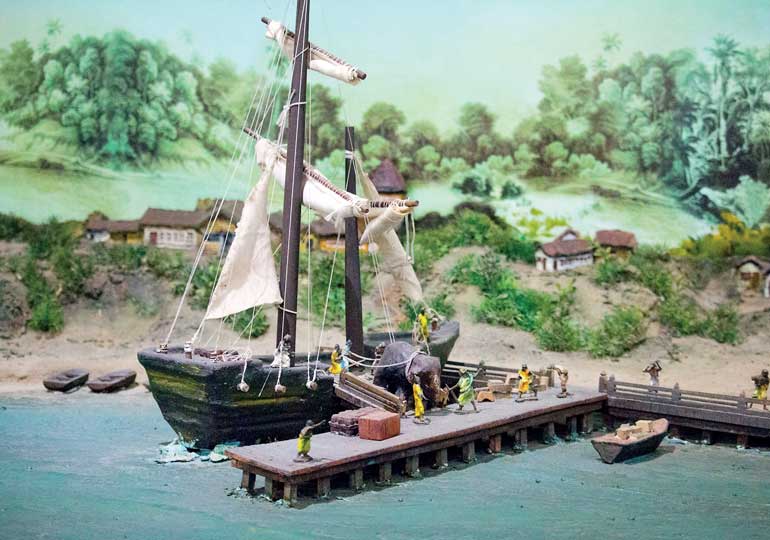Thursday Apr 25, 2024
Thursday Apr 25, 2024
Saturday, 17 March 2018 00:00 - - {{hitsCtrl.values.hits}}

By Aysha Maryam Cassim
Sri Lanka possesses a significant marine archaeological history belonging to a timespan exceeding 2,500 years and much of its maritime culture has been brought down to heritage as archaeological proof and property.
The naval and maritime museum in Trincomalee displays ancient Ceylon’s historical and chronological association with the ocean. Located on Dockyard Road within city limits, this museum is worth a visit during your tour to Fort Frederick and Koneswaram Temple. It is one of the most beautifully crafted and well-maintained museums in Sri Lanka where one can get an insight into Trincomalee’s glorious naval past through a collection and preservation centered upon the sea.
It’s worth taking the guided tour from one of the in-house archaeologists. Ruwan, a young and enthusiastic officer of the Department of Archaeology, walked us through the museums and provided us with valuable details of every exhibit.
A dilapidated Dutch building gets a makeover
The building which houses the museum is a great exhibit of an old colonial building which was restored from ruins with the assistance of the Dutch Government. It was interesting to see the photos that showcased its renovation process prior to the opening of the museum in 2014. It turns out that the building fell into neglect during the 1970s and remained in a dilapidated state for more than three decades.
The first floor is entirely reserved to remind us of the building’s forgotten history. There is one pillar in the first floor balcony that is deliberately kept untouched to give a glimpse of the past.
 Sri Lanka’s maritime trade connections between East and West
Sri Lanka’s maritime trade connections between East and West
Archaeological excavations conform that Sri Lanka’s maritime trade connections had played an important role in maintaining international relations concerning religious, cultural, social, economic and also political mediums between the East and the West. This positively helped the island to be more civilised and thrive in terms of culture and commerce.
Naval expeditions that started from India stopped over at the ports of Sri Lanka since the middle period of Anuradhapura to the colonial eras of Portuguese (1505-1652), Dutch (1658-1796), English (1796-1948.) Numerous shipwrecks found in Manthaasi, Gokanna, Godawaya and also Kirinda reveal many details about ancient trade associations of Sri Lanka.
From 2nd to the 1800 A.C, the small island called Taprobane was a strategically and economically important location in the Indian Ocean for the Romans, Greeks, Chinese, Russians, and people from the Gulf. Sri Lanka has also had relations with West Asian countries by oceanic trade ways through the Silk Route.
Historical records mention that vessels weighing about 200 tons and with capacity for carrying 300-500 passengers or even 700 at times appear to have been used for trade between India, Babylon and Suvannabhumi (Burma), etc.
For centuries, Sri Lankan shipbuilding has been on a steady development. Egyptian writer Plini during the 1st B.C has written that Sri Lankan vessels were capable of carrying 3000 ‘amphora’ or 75 tons. According to the Arabian geographer Al Idris (1155 AD), Sri Lanka produced larger ships and foreign merchants came to the country in search of raw materials for ships.
The oldest wreck found in Godawaya
At the museum there is a model of an ancient ship indicated as the replica of a sunken age-old wreck found near the southern port of Godawaya. This belongs to a period of 2nd-1st B.C as revealed by the dating processes. Remnants of this wooden ship are identified as the oldest shipwreck found up to date on the Asian continent.
The Marine Archaeological Department and the Central Cultural Fund together with master divers from the Godawaya area conducted the marine exploration and excavation in 1998. The excavations have yielded artefacts including a stone bench with auspicious symbols, a stone anchor, pottery and few ingots of glaze. According to archaeologists, these antiques cleared from the shipping point towards an era of early Anuradhapura.
History of Sri Lanka’s naval affairs
“Duwegala rock inscription (2nd-1st B.C.) depicts a symbol of a ship indicating that prior to the Christian era, Sri Lankans had the knowledge of the construction of the ship and the words ‘navika’ (sailors) used in Paramanaknda and Maligatenna inscriptions confirm this fact.”
The history of Sri Lanka’s naval affairs is mentioned in chronicles such as the Mahavamsa, Digha Nikaya, travelling accounts, and historical epigraphs. From the landing of Vijaya in Tambapanni to the arrival of Princess Bhaddakaccana and her six brothers at the port of Gokanatittha (present-day Trincomalee) reveals that the coastline of Sri Lanka had been attracting vessels since the 6th century BC.
There had been such a vast number of vessels on the seas at that time that the Mahavamsa says that the great ocean looked like a single city. It was not just traders, travellers and royal families who set sailed to the island of Taprobane, but South Indian invaders too came with their troops to Sri Lanka from India with a fleet consisting of thousands of ships adorned with elaborate designs.
Apart from marine archaeology and international maritime relationships, the exhibits at the Maritime and Naval History Museum in Trincomalee also give the visitor an interactive educational experience on the commencement and evolution of naval craft and tools and techniques used in maritime technology and communications, maritime warfare as well as commerce, tourism, maritime cultures, traditions and environments.
